 Crail Harbour |
The Kingdom of Fife occupies the peninsula formed by the Firth of Forth to the South and the Firth of Tay to the north. It isn't an island but until relatively recent times you needed a ferry or a long detour to reach it from most other parts of Scotland. Fife's existence as a distinct entity can be traced back to the Pictish Kingdom of Fib in the centuries after the departure of the Romans. It is for this reason that Fife is commonly referred to as "The Kingdom of Fife", or simply "The Kingdom". For accommodation in the area see the links in the "See and Stay" menu above. See the map below for an outline of the area and links to surrounding areas.
The western half of Fife is an area whose character is formed by three very different influences: history, industry, and the sea. The historical influence is most evident in Dunfermline, and at Culross. Dunfermline served as a Royal residence and burial place for many centuries. It is said to be home to the remains of eight Scottish kings, four queens and assorted princes and princesses. Today this history is seen most strikingly in the Abbey Church and the nearby ruins of Dunfermline Abbey, later converted into a royal palace by James VI's Queen, Anne of Denmark. Dunfermline can also offer the outstanding Dunfermline Carnegie Library & Galleries, The Andrew Carnegie Birthplace Museum, and one of Scotland's more unusual visitor attractions, St Margaret's Cave.
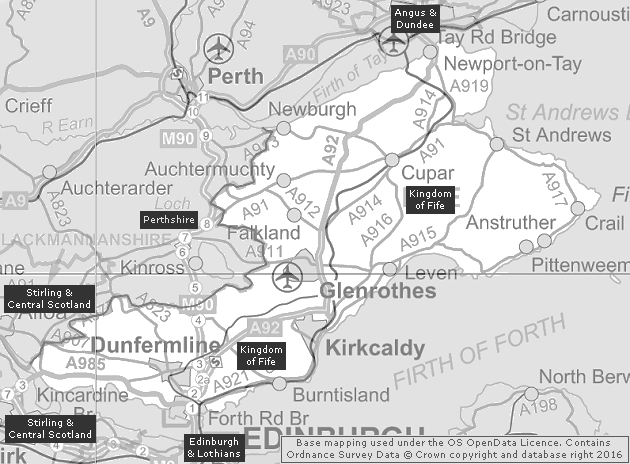 Kingdom of Fife, Showing Main Settlements & Connecting Areas |
Other finds in the area are more of a surprise, like Scotland's first castle of the artillery age, Ravenscraig Castle, on the edge of Kirkcaldy, or Rosyth Castle, now almost surrounded by dockyard development. Meanwhile, Tulliallan Kirkyard is home to one of the best collections of old gravestones in Scotland. A glimpse of an even older history can be seen at Balfarg Henge and Balbirnie Stone Circle on the eastern edge of Glenrothes. Near to both is the imposing Balbirnie House, now a fine hotel.
Further west, a remarkable segment of history is preserved at Culross, on the banks of the River Forth a short distance east of the Kincardine Bridge. Here you find a time capsule from the 16th century, complete with the remains of an abbey, a fascinating abbey church, a palace (in fact a great hall) and a stunning collection of other buildings. To its east are the twin villages of Charlestown and Limekilns, whose tranquility today also conceal their industrial beginnings.
The area's past wealth was largely built on the coal mining industry. There was a time when a large number of pits operated across the length of southern Fife, leaving distinctive settlements like Cowdenbeath, Lochgelly, Cardenden, Kelty, and Kinglassie. Two examples of rather different ex-coal mining and exporting villages are Dysart and West Wemyss, both east of Kirkcaldy. Meanwhile, Levenmouth, the conurbation that includes the towns of Leven, Methil and Buckhaven also has a history in which coal has featured large. This history is told in the Methil Heritage Centre.
At the other end of the industrial spectrum is the "new town" of Glenrothes. This has attracted a range of modern manufacturing and service industries, a trend that continues here and around the M90 as businesses seek to benefit from the proximity to Edinburgh without the capital's land prices. Immediately to its west is the long established town of Leslie.
Elsewhere on the Forth coast, tourist gems like Aberdour, Limekilns and Culross intermingle with traditional holiday resorts like Kinghorn. Meanwhile the port and industry of places like Rosyth, Burntisland and Inverkeithing intermingle with the new development of places like Dalgety Bay: which is home to the ruins of St Bridget's Church. Further along the coast, Aberdour Castle and the nearby St Fillan's Church are especially worth visiting, as is the historically important Burntisland Parish Church.
The construction of the first Kincardine Bridge in 1936 displaced Stirling as the location of the furthest downstream road bridge over the Forth (the second, the Clackmannanshire Bridge, was completed in November 2008). This was itself displaced by the completion of the much more spectacular Forth Road Bridge linking North Queensferry and South Queensferry in 1964. Close by is the highly distinctive structure of the Forth Rail Bridge, completed in 1890. At its northern end this towers over the old quarry now used as a home for Deep Sea World. Construction is now under way for a second Forth Road Bridge.
The most important settlement in the eastern part of Fife is St Andrews, Scotland's oldest university town, perhaps best known as the home of golf. It sits on a wide bay on the north-east coast of Fife. The town is easily explored on foot. A mix of university buildings are to be found alongside shops and restaurants, much as in Oxford or Cambridge.
The ruins of St Andrews Cathedral, once the largest and most magnificent cathedral in the country, lies at the eastern end of North Street. As well as the cathedral itself, visitors can tour the excellent Cathedral Museum or climb St Rule's Tower, which offers superb views in all directions. St Andrews developed as the ecclesiastical capital of the country and became a place of pilgrimage. In 1200 a castle was built for the bishop, part residence, part fortress. In the 1450s the young King James II was a frequent visitor (see our Historical Timeline).
The association of St Andrews with golf dates to the 1400s, with the famous Old Course being constructed in the 1500s. Overlooking the Old Course is the magnificent Old Course Hotel. In all, St Andrews boasts the Old Course plus five other public courses in the area. It is also home to the excellent British Golf Museum. Nearby is the St Andrews Aquarium.
Across the estuary of the River Eden from St Andrews is RAF Leuchars, home each September to one of the UK's best airshows. This sits alongside the attractive village of Leuchars, whose Parish Church contains some of the finest Norman architecture in the country.
To the south of St Andrews is the East Neuk, a region of quaint fishing villages which include Crail, Pittenweem, St Monans and Elie. East of St Monans is St Monans Windmill and the site of the associated salt pans, while to its west are the remains of Newark Castle and Ardross Castle. Just inland from the coast are the attractive villages of Boarhills and Kingsbarns. Near the latter is the superb Kingsbarns Distillery and Visitor centre. A little further west are the paired villages Upper Largo and Lower Largo.
Anstruther is home to the Scottish Fisheries Museum. It tells the story of the fishing industry from the earliest times to the present day and is open all year. Only half a mile away from Anstruther is Cellardyke, a fishing settlement once more important than Anstruther itself. Inland lies the ancient hamlet of Kilrenny.
Inland between Crail and Anstruther is Scotland's Secret Bunker, a site that was to become the country's seat of government in the event of a nuclear war. Inland from St Monans is Kellie Castle.
Falkland Palace, in the village of Falkland, is a stunning example of Early Renaissance architecture and both palace and gardens are open to the public during the summer months. A little to its north and on the line of the A91 are Auchtermuchty and Strathmiglo.
Cupar, the capital of Fife, is a market town, which retains much of its medieval character. It is situated at the centre of Fife's road network and is on the railway line to Dundee. A little to its south is Scotstarvit Tower, close to another attraction the Hill of Tarvit mansion house and to the attractive village of Ceres. Not far away is Cults Kirk. Between Ceres and the coast is an area that is home to two outstanding inns offering accommodation and outstanding food, The Peat Inn and the Inn at Lathones.
Fife's north coast looks across the River Tay to Dundee. Until the building of the Tay Rail Bridge, a railway ferry operated from Tayport, near the north-east tip of Fife, while just along the river, Newport-on-Tay has effectively become a cross-river suburb of Dundee. South of them are the ruins of St Fillan's Church. On a minor road four miles west of Newport-on-Tay are the ruins of Balmerino Abbey. Further east you find the ruins of Lindores Abbey, on the edge of the town of Newburgh. Nearby is the outstanding Lindores Abbey Distillery.
Driving Tours: The south-west of the area is traversed by our Stirling & Dunfermline Driving Tour. Glenrothes is the starting point for our Falkland & St Andrews Driving Tour.

|
|
|
 St Andrews From St Rule's Tower |
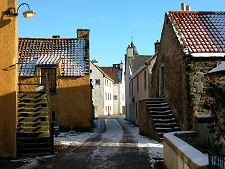 Culross |
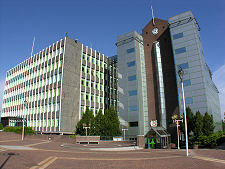 Glenrothes |
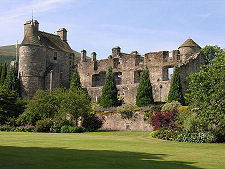 Falkland Palace |
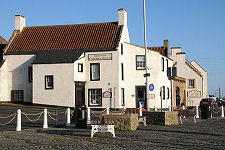 Scottish Fisheries Museum |
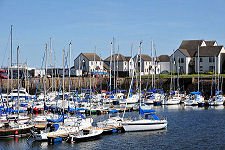 Tayport |
 Anstruther Harbour |
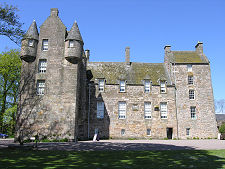 Kelllie Castle |
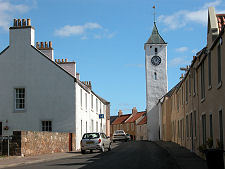 West Wemyss |

